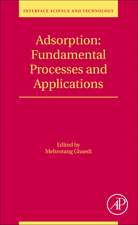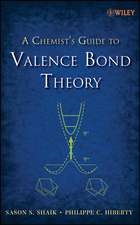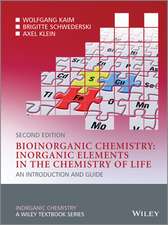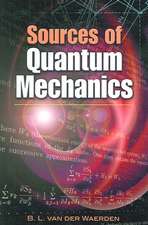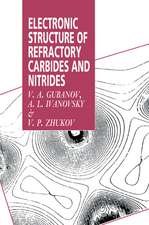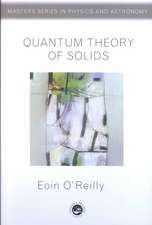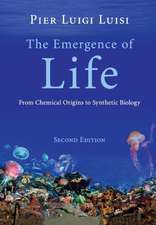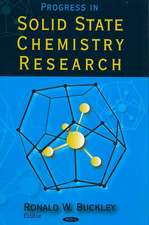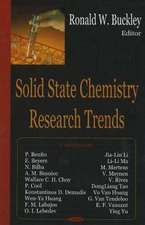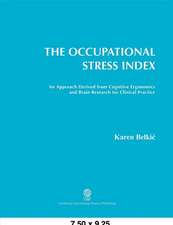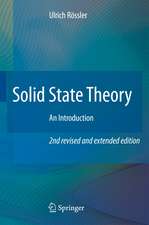Solid State Chemistry and its Applications 2e Student Edition
Autor A Westen Limba Engleză Paperback – 27 feb 2014
Preț: 351.37 lei
Nou
67.24€ • 69.80$ • 56.07£
Carte disponibilă
Livrare economică 04-18 martie
Livrare express 15-21 februarie pentru 69.67 lei
Specificații
ISBN-10: 1119942942
Pagini: 582
Dimensiuni: 189 x 246 x 28 mm
Greutate: 1.24 kg
Ediția:2nd Edition, Student Edition
Editura: Wiley
Locul publicării:Chichester, United Kingdom
Public țintă
Undergraduate Students in inorganic and physical chemistry, materials science, solid state physics and engineering.Cuprins
Preface xv Chemistry - Solid State Chemistry -Materials Chemistry -Materials Science and Engineering xvii Companion Website xxi CrystalViewer xxii Biography xxiii 1 Crystal Structures and Crystal Chemistry 1 1.1 Unit Cells and Crystal Systems 1 1.2 Symmetry 3 1.3 Symmetry and Choice of Unit Cell 10 1.4 Lattice, Bravais Lattice 11 1.5 Lattice Planes and Miller Indices 14 1.6 Indices of Directions 16 1.7 d-Spacing Formulae 17 1.8 Crystal Densities and Unit Cell Contents 17 1.9 Description of Crystal Structures 18 1.10 Close Packed Structures - Cubic and Hexagonal Close Packing 19 1.11 Relationship Between Cubic Close Packed and Face Centred Cubic 21 1.12 Hexagonal Unit Cell and Close Packing 21 1.13 Density of Close Packed Structures 22 1.14 Unit Cell Projections and Atomic Coordinates 24 1.15 Materials That Can Be Described as Close Packed 25 1.16 Structures Built of Space-Filling Polyhedra 33 1.17 Some Important Structure Types 35 2 Crystal Defects, Non-Stoichiometry and Solid Solutions 83 2.1 Perfect and Imperfect Crystals 83 2.2 Types of Defect: Point Defects 84 2.3 Solid Solutions 95 2.4 Extended Defects 108 2.5 Dislocations and Mechanical Properties of Solids 111 3 Bonding in Solids 125 3.1 Overview: Ionic, Covalent, Metallic, van der Waals and Hydrogen Bonding in Solids 125 3.2 Ionic Bonding 126 3.3 Covalent Bonding 161 3.4 Metallic Bonding and Band Theory 173 3.5 Bands or Bonds: a Final Comment 185 4 Synthesis, Processing and Fabrication Methods 187 4.1 General Observations 187 4.2 Solid State Reaction or Shake 'n Bake Methods 187 4.3 Low Temperature or Chimie Douce Methods 196 4.4 Gas-Phase Methods 213 4.5 High-Pressure Methods 225 4.6 Crystal Growth 226 5 Crystallography and Diffraction Techniques 229 5.1 General Comments: Molecular and Non-Molecular Solids 229 5.2 Characterisation of Solids 231 5.3 X-Ray Diffraction 232 5.4 Electron Diffraction 265 5.5 Neutron Diffraction 266 6 Other Techniques: Microscopy, Spectroscopy, Thermal Analysis 271 6.1 Diffraction and Microscopic Techniques: What Do They Have in Common? 271 6.2 Optical and Electron Microscopy Techniques 272 6.3 Spectroscopic Techniques 291 6.4 Thermal Analysis (TA) 314 6.5 Strategy to Identify, Analyse and Characterise 'Unknown' Solids 323 7 Phase Diagrams and Their Interpretation 325 7.1 The Phase Rule, the Condensed Phase Rule and Some Definitions 325 7.2 One-Component Systems 330 7.3 Two-Component Condensed Systems 333 7.4 Some Tips and Guidelines for Constructing Binary Phase Diagrams 355 8 Electrical Properties 359 8.1 Survey of Electrical Properties and Electrical Materials 359 8.2 Metallic Conductivity 361 8.3 Superconductivity 366 8.4 Semiconductivity 382 8.5 Ionic Conductivity 392 8.6 Dielectric Materials 430 8.7 Ferroelectrics 436 8.8 Pyroelectrics 441 8.9 Piezoelectrics 441 8.10 Applications of Ferro-, Pyro- and Piezoelectrics 441 9 Magnetic Properties 445 9.1 Physical Properties 445 9.2 Magnetic Materials, Their Structures and Properties 455 9.3 Applications: Structure-Property Relations 464 9.4 Recent Developments 467 10 Optical Properties: Luminescence and Lasers 473 10.1 Visible Light and the Electromagnetic Spectrum 473 10.2 Sources of Light, Thermal Sources, Black Body Radiation and Electronic Transitions 473 10.3 Scattering Processes: Reflection, Diffraction and Interference 476 10.4 Luminescence and Phosphors 476 10.5 Configurational Coordinate Model 478 10.6 Some Phosphor Materials 480 10.7 Anti-Stokes Phosphors 481 10.8 Stimulated Emission, Amplification of Light and Lasers 482 10.9 Photodetectors 488 10.10 Fibre-Optics 490 10.11 Solar Cells 492 Further Reading 493 Appendix A: Interplanar Spacings and Unit Cell Volumes 505 Appendix B: Model Building 507 Appendix C: Geometrical Considerations in Crystal Chemistry 511 Appendix D: How to Recognise Close Packed (Eutactic) Structures 515 Appendix E: Positive and Negative Atomic Coordinates 517 Appendix F: The Elements and Some of Their Properties 519 Questions 525 Index
Notă biografică
Anthony West is Professor of Electroceramics and Solid State Chemistry in the Department of Materials Science & Engineering at Sheffield University. Having spent most of his academic career at the University of Aberdeen, where he developed a lifetime interest in the then-emerging field of solid state chemistry with special interest in synthesis of new oxide materials, their crystal structures and electrical properties, Professor West moved to Sheffield University in 1999 as Head of Department, a post he held until 2007. In addition to writing several bestselling books on Solid State Chemistry, Tony was founding editor of the Journal of Materials Chemistry and founding Chairman of the Materials Chemistry Forum of the Royal Society of Chemistry. He is a former President of the Inorganic Chemistry Division of IUPAC. Professor West is a Fellow of the RSC, the Institute of Physics, the Institute of Materials, Mineral and Mining, and the Royal Society of Edinburgh. He previously received an Industrial Award in Solid State Chemistry from the RSC, 1996, the Griffiths Medal and Prize from the IOM3, 2008, the Epsilon de Oro Award from the Spanish Society of Glass and Ceramics, 2007, and the Chemical Record Lectureship from the Chemical Societies of Japan, 2009. He has been awarded the 2013 RSC John B. Goodenough Award in Materials Chemistry, a lifelong recognition award for his contributions to the field.
Descriere
Solid State Chemistry and its Applications, 2nd Edition: Student Edition is an extensive update and sequel to the bestselling textbook Basic Solid State Chemistry, the classic text for undergraduate teaching in solid state chemistry worldwide. Solid state chemistry lies at the heart of many significant scientific advances from recent decades, including the discovery of high-temperature superconductors, new forms of carbon and countless other developments in the synthesis, characterisation and applications of inorganic materials. Looking forward, solid state chemistry will be crucial for the development of new functional materials in areas such as energy, catalysis and electronic materials. This revised edition of Basic Solid State Chemistry has been completely rewritten and expanded to present an up-to-date account of the essential topics and recent developments in this exciting field of inorganic chemistry. Each section commences with a gentle introduction, covering basic principles, progressing seamlessly to a more advanced level in order to present a comprehensive overview of the subject. This new Student Edition includes the following updates and new features: * Expanded coverage of bonding in solids, including a new section on covalent bonding and more extensive treatment of metallic bonding. * Synthetic methods are covered extensively and new topics include microwave synthesis, combinatorial synthesis, mechano-synthesis, atomic layer deposition and spray pyrolysis. * Revised coverage of electrical, magnetic and optical properties, with additional material on semiconductors, giant and colossal magnetoresistance, multiferroics, LEDs, fibre optics and solar cells, lasers, graphene and quasicrystals. * Extended chapters on crystal defects and characterisation techniques. * Published in full colour to aid comprehension. * Extensive coverage of crystal structures for important families of inorganic solids is complemented by access to CrystalMaker(r) visualization software, allowing readers to view and rotate over 100 crystal structures in three dimensions. * Solutions to exercises and supplementary lecture material are available online. Solid State Chemistry and its Applications, 2nd Edition: Student Edition is a must-have textbook for any undergraduate or new research worker studying solid state chemistry.

